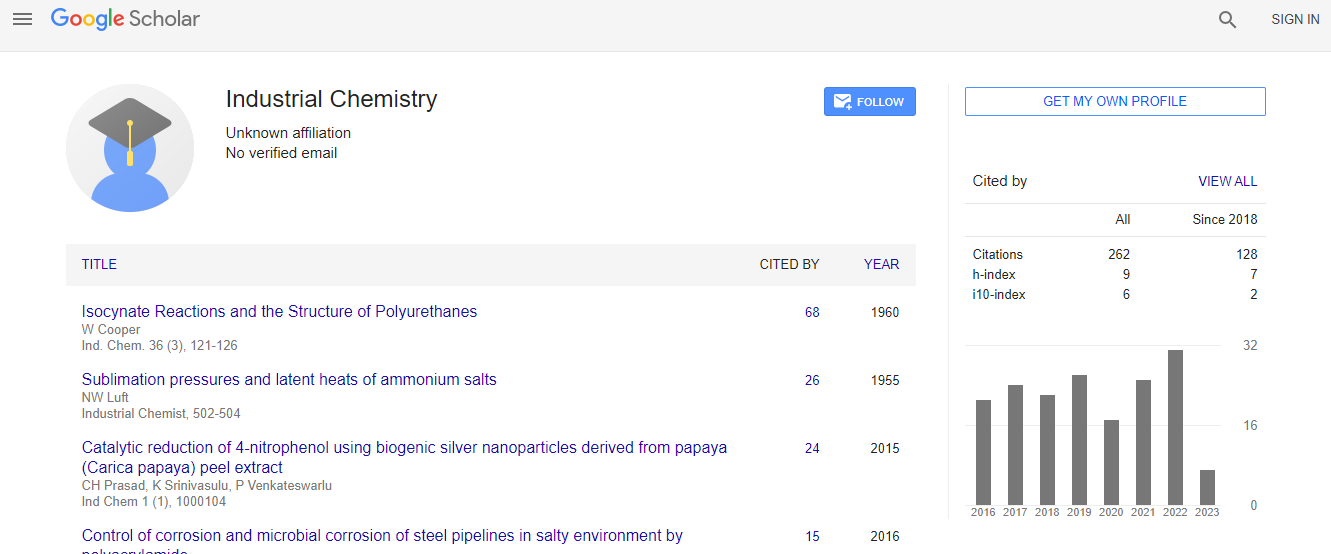Our Group organises 3000+ Global Conferenceseries Events every year across USA, Europe & Asia with support from 1000 more scientific Societies and Publishes 700+ Open Access Journals which contains over 50000 eminent personalities, reputed scientists as editorial board members.
Open Access Journals gaining more Readers and Citations
700 Journals and 15,000,000 Readers Each Journal is getting 25,000+ Readers
Google Scholar citation report
Citations : 262
Industrial Chemistry received 262 citations as per Google Scholar report
Indexed In
- Index Copernicus
- Google Scholar
- RefSeek
- Directory of Research Journal Indexing (DRJI)
- Hamdard University
- EBSCO A-Z
- OCLC- WorldCat
- Scholarsteer
- Geneva Foundation for Medical Education and Research
- Euro Pub
Useful Links
Recommended Journals
Related Subjects
Share This Page
Enzyme as useful catalyst for precision synthesis of functional polysaccharide materials
17th International Conference on Industrial Chemistry and Water Treatment
Jun-ichi Kadokawa
Kagoshima University, Japan
Keynote: Ind Chem
Abstract
Natural polysaccharides such as cellulose, starch, and chitin are widely distributed in nature and thus considered as the very important biomass resources. They can also be expected as functional materials, which are applicable in biomedical, tissue engineering, and environmentally benign fields. Therefore, the efficient methods for synthesis of functional polysaccharides have attracted much attention to provide new materials employed in such application fields. Enzymatic approaches have increasingly been important to precisely synthesize functional polysaccharide materials. Phosphorylase is one of the enzymes, which have been practically employed as catalysts for the synthesis of polysaccharides with well-defined structures. This enzyme catalyzes enzymatic polymerization of �±-D-glucose 1-phosphate (Glc-1-P) as a monomer initiated from the nonreducing end of maltooligosaccharide primer to produce �±(1�³4)-glucan, that is amylose (Figure 1). The author has reported precision synthesis of functional polysaccharide materials by phosphorylase-catalyzed enzymatic reactions. By means of the property of spontaneously double helix formation from amyloses, for example, it was reported that the phosphorylase-catalyzed enzymatic polymerization using the immobilized primers forms network structures composed of the double helix cross-linking points. In most cases, accordingly, the enzymatic polymerization solutions have turned into hydrogels with high water contents. As an example, the phosphorylase-catalyzed enzymatic polymerization using the immobilized primers on chitin nanofibers was investigated to produce amylose-grafted chitin nanofiber hydrogels. On the other hand, the author has also reported that by means of the phosphorylase-catalyzed enzymatic polymerization using analog substrates as monomers, well-defined polysaccharides with functional groups are efficiently obtained. For example, phosphorylase isolated from thermophilic bacteria, Aquifex aerolicus VF5, catalyzed the enzymatic polymerization of �±-D-glucosamine 1-phosphate (GlcN-1-P) as a monomer from maltotriose primer. The enzymatic reaction was accelerated in ammonia buffer containing Mg2+ ion, owing to the precipitation of inorganic phosphate, giving the high molecular weight aminopolysaccharide, which corresponded to chitosan stereoisomer.Biography
Jun-ichi Kadokawa has received his PhD in 1992. He then joined Yamagata University as a Research Associate. From 1996 to 1997, he worked as a Visiting Scientist at the Max-Planck-Institute for Polymer Research in Germany. In 1999, he became an Associate Professor at Yamagata University and moved to Tohoku University in 2002. He was appointed as a Professor of Kagoshima University in 2004. His research interests focus on polysaccharide materials. He has received the Award for Encouragement of Research in Polymer Science (1997) and the Cellulose Society of Japan Award (2009). He has published more than 200 papers in academic journals.

 Spanish
Spanish  Chinese
Chinese  Russian
Russian  German
German  French
French  Japanese
Japanese  Portuguese
Portuguese  Hindi
Hindi 